As I recall it (correct me if I'm wrong cause it's been a while) you can add "cheap" copper pass-through modules if you don't want to take the networking module cost up-front. That way you can access the blade NICs from the center backside - but it kinda defeats the purpose with a bladecenter.
There should be a couple of different networking module options, cheaper and more expensive depending on whether you want - say Cisco manageable level 3 routing in them or not and so on, see the tech sheets list.
The chassis I'm used to hard-routed one blade NIC to one networking module bay and the other blade NIC to the other networking bay - so if you needed both NICs on a blade you needed two networking modules. You could also add another two networking modules (or FC modules and so on) and the corresponding module to a blade to get two additional interconnects of your choosing.
There are loads to regard, the power modules power specific blade and expansion module slots (first two included power modules power blade bay 1-7 and expansions bay 1-4 - to use blade bay 8-14 and expansion module 5-10 you need two additional power modules).
The center should come with at least one management module, otherwise you need to add one. The blowers are fun to play with (rebooting management module ;)
Most questions should be answered by your hardware partner or vendor imho as it gives you the chance to ask more intricate questions about interoperability, licensing and additional costs.
Here's a list of tech sheets for different modules and the center itself and this is the installation user guide which is fairly detailed.

(source: keenzo.com)
About the power cords, they're most likely not what you're used to and may need some local help from your electrician - order the specific BladeCenter H power cables. They each need three "standard" UPS power outlets which powers different parts of the chassis (so some can be left unplugged if you've only filled half the center with blades as I recall). During startup or when the management module is rebooting/offline - the blowers are uncontrolled, creating a decently sized storm and drawing a lot of power.
